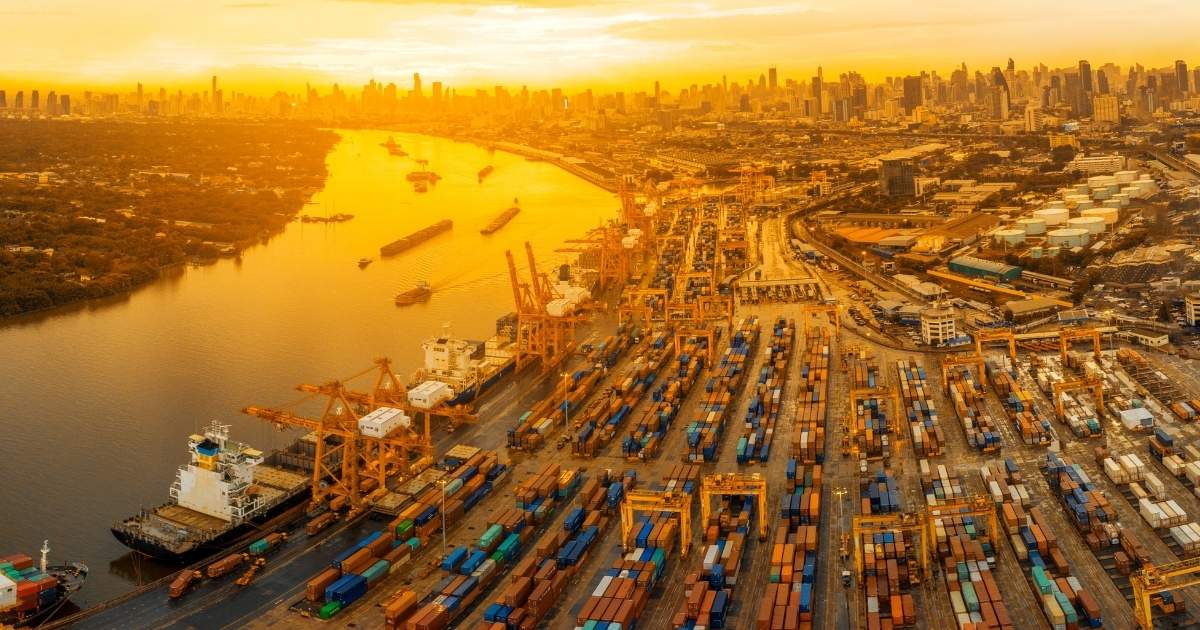The maritime industry has consistently set records with groundbreaking advancements in speed, size, efficiency, and environmental innovation.
As one of the largest industries powering international commerce, shipping companies and ports are pushing the boundaries in shipbuilding, port infrastructure, and sustainable practices.
This article explores the maritime industry’s superlatives—from the fastest ships and busiest ports to the largest vessels and pioneering environmental firsts.
Each of these achievements not only highlights the evolution of maritime technology but also reflects the industry’s impact on global trade efficiency and environmental goals.
The Fastest
Fastest Merchant Ship
The fastest ship in the world today is the Passenger/Ro-Ro Ship FRANCISCO, a 7,109 gross-tonnage vessel that can achieve a maximum speed of 58.1 knots or 67 mph (107 km/h).
Also named HSC FRANCISCO, this catamaran ferry easily plies the 146-nautical-mile route between Buenos Aires and Montevideo in about two and a half hours.
That same distance would take twelve hours for tankers to traverse.
Fastest Port Turnaround Times
Port turnaround time (PTT) refers to the total time a vessel spends within a port, measured from its arrival at the port boundary to its departure.
In this metric, Japan leads the world with impressively efficient container terminals, achieving an average port turnaround time of just 0.36 days—or a swift 8.64 hours, according to Statista.
This efficiency ensures swift cargo handling and minimizes delays.
In contrast, U.S. ports average 1.25 days (30 hours) PTT, highlighting Japan’s superior port management.
The Largest
Largest Merchant Ship
The title of the largest merchant ship currently goes to the MSC Irina, a massive container vessel with an overall volume capacity of 236,184 gross tons (GT).
Measuring 400 meters in length with a 61-meter beam, MSC Irina can carry an impressive 24,346 twenty-foot equivalent units (TEU) under the Liberian flag.
In terms of historical size records, MT Mont (also known as the Seawise Giant, Happy Giant, Jahre Viking, and Knock Nevis) holds a special place.
This gigantic vessel, built in 1979, reached an astonishing 458 meters in length, had a gross tonnage of 260,941 GT, and a deadweight capacity (DWT) of 564,763. MT Mont was scrapped in 2010.
Largest Sea Port
The Port of Shanghai holds the title of the largest seaport in the world, maintaining this position for 14 consecutive years!
Spanning an impressive 3,619.6 square kilometers, the Port of Shanghai handled 49.16 million TEUs (twenty-foot equivalent units) in 2023, setting a global benchmark for container throughput.
Located strategically at the mouth of the Yangtze River, this mega-port comprises 191 berths, 156 container cranes, and 43 container terminals.
Largest Ship Owning Country
Greece tops the list as the largest shipowning country, boasting an impressive 394,977,181 deadweight tonnage (DWT) according to the UNCTAD report Review of Maritime Transport 2024.
This surpasses China’s 309,870,897 DWT despite China having more vessels (9,418 vs. Greece’s 4,992).
This emphasis on high-capacity vessels has solidified Greece’s status as a key player in global shipping capacity, positioning it as the world’s leading shipowning nation.
Largest Shipping Company
The Mediterranean Shipping Company (MSC) reigns as the world’s largest shipping company by revenue, generating $91 billion in 2022, according to the Italian magazine Il Messaggero.
This private Italian firm dominates 20.1% of the global container shipping fleet, surpassing Maersk’s $81.5 billion consolidated revenue.
While MSC’s 2024 revenue remains undisclosed due to its private ownership, the company’s consistent expansion and substantial market share suggest it retains the top spot.
Largest Seafarer Supply Country
According to the Seafarer Workforce Report, the Philippines ranks as the world’s largest supplier of seafarers, providing both officers and ratings to the global maritime workforce.
Filipino seafarers comprise 13.33% of the world’s maritime workforce, outperforming other major contributors such as Russia (10.47%) and Indonesia (7.59%).
Out of approximately 1,892,720 seafarers deployed on vessels worldwide at any given time, 252,299 are Filipinos, solidifying the Philippines’ status as the number one provider of seafarers. Russia follows with 198,123 seafarers.

The Busiest
Busiest Ports by Cargo Volume
Aside from being the largest port, the Port of Shanghai also holds the record for being the busiest seaport in the world, with 49.16 TEUs (2023).
Shanghai Port handles all sorts of ships and cargoes, such as steel, coal, petroleum, petroleum products, metal ore, and machinery and equipment.
Due to its activity, the Port of Shanghai handles 514 million tons of cargo and manages about 200 vessel arrivals every 24 hours.
Busiest Shipping Routes
The Dover Strait is the busiest shipping lane in the world, with over 400 commercial vessels navigating its mandatory reporting points daily, according to the Dover Strait Channel Vessel Traffic Service (VTS).
This crucial passage located between France and the United Kingdom is about 20 miles wide. It has an average depth of 46 meters.
As the primary maritime gateway between Northern Europe and global trade routes, the Dover Strait facilitates the annual movement of approximately 1.4 billion tons of cargo.
Busiest Canal
The Kiel Canal is the world’s busiest canal, facilitating 26,000 ship transits annually and transporting 77 million tonnes of goods.
The 99-kilometer-long canal reaches a depth of 11 meters. Equipped with two sets of locks at Holtenau and Brunsbüttel, Kiel Canal is available 24/7, 365 days per year.
The canal’s width ranges from 102 meters to 214 meters, accommodating a variety of vessel sizes.
Sailing through the Kiel Canal saves approximately 424 miles (682 km) on the journey from the Baltic Sea to Bremerhaven (136 miles) compared to navigating around Skagen (560 miles).
The First
First Autonomous, Electric Ship
The first autonomous ship is the Yara Birkeland, an electric, fully autonomous container ship launched by Yara International in Norway.
Officially completed in 2020 and tested extensively through 2021 and 2022, Yara Birkeland was designed to reduce emissions and streamline cargo transportation along Norway’s coast.
There are currently people on the bridge at all times since regulations require it, but the ship operates autonomously, even using robot arms for mooring.
First Ship to Use LNG as Fuel
The MV Viking Energy, operated by Eidesvik Offshore in Norway, made maritime history in 2003 as the first commercial vessel powered by Liquefied Natural Gas (LNG).
The LNG-fueled supply vessel has a bunker storage capacity of 105 MT of LNG and uses a Battery Hybrid system.
Looking ahead, Viking Energy is set for another transformation. In 2026, Eidesvik Offshore plans to retrofit the vessel to operate on ammonia as its primary fuel source, which will help reduce carbon emissions in the shipping sector.
Conclusion
The maritime industry has reached remarkable milestones, pushing the boundaries of speed, size, efficiency, and sustainability.
From the fastest ships like the FRANCISCO to the largest vessels like the MSC Irina, and from the busiest ports like Shanghai to pioneering environmental innovations like the Yara Birkeland and MV Viking Energy, the industry continues to evolve.
These remarkable feats illustrate the industry’s role as a backbone of global trade, highlighting how advancements in shipbuilding, alternative fuels, and efficient port operations continue to shape international commerce.
May the winds be in your favor.


Leave a Reply